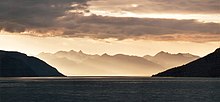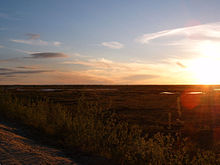Polar day


The polar day is in the polar regions , a period around the solstices , in the northern polar region to the summer solstice in June. The midnight sun does not sink below the horizon for at least one day . So it is bright all day, apart from a little twilight at midnight on the fringes of the polar regions.
At the geographic North Pole and South Pole , polar days last six months, at the polar circles it is exactly one day on which the sun does not set. Because of the astronomical refraction , it can still be experienced just outside the polar regions.
At the poles, the sun circles at almost the same height for 24 hours, on the day of the summer solstice about 23.5 ° above the horizon. During the next three months it slowly moves in a spiral downwards towards the horizon. The sun rises and sets once a year, namely when its apparent orbit intersects the equatorial plane of the earth, i.e. at the time of the equinoxes . During this transition period, the sun can only be partially seen when it rises or sets, while it wanders along the horizon. When it is just a little below the horizon, it is twilight and it lasts for several weeks.
See also
Web links
- Webcam and weather data from Tromsø University
- Sunrises and sunsets for famous places
Remarks
- ↑ Since the duration of the time intervals between the equinoxes is not the same, polar days do not last the same length either; Arctic are some days d longer than Antarctic.
